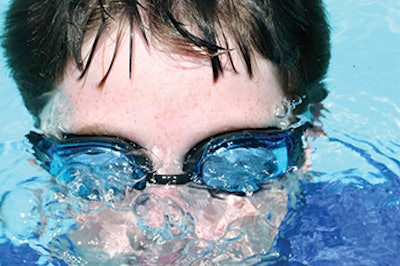
Scientific foundation for this article was provided by Zach Hansen, technical services engineer at BioLab. Mr. Hansen has a Bachelor of Science in Chemical Engineering from Auburn University and an MBA from Georgia State.
Chlorine for pools, bromine for spas. That's the conventional wisdom for sanitizing, but like most conventional wisdom, there are circumstances when it's not so wise.
Over many decades, chlorine has been tried and found to be a true and lethal germ-killer and waste oxidizer in outdoor pools, but it's sister halogen, bromine, makes a good case for use in an enclosed space. Mostly, that argument boils down to the fact that bromamines (a major by-product of bromine pool chemistry) are a lot easier to deal with than their counterpart, chloramines, especially in commercial pools with large bather loads.
Shocking procedures
{bglink 3858}There are no doubts about chlorine's ability to kill and oxidize pool invaders. The halogen's problems begin after it's done its work.
Once chlorine has reacted with another molecule and become combined chlorine (chloramine), it becomes quite feeble as a sanitizer. But when bromine reacts and becomes a bromamine molecule, it retains its sanitizing efficacy. Bromamines floating around in the water will be able to attack and kill bacteria just about as effectively and quickly as either free chlorine or free bromine.
So while bromamines are a positive good in pool water, chloramines pose a problem in any pool. They build up over time and must be eradicated through breakpoint oxidation. The standard practice in the industry is to dump in a large amount of chlorine to shock the pool, usually in a 10-to-1 ratio of free chlorine to combined chlorine.
Cl
Name: Chlorine Atomic number: 17 Atomic weight: 35.453 Melting point: -150.7 °F Boiling point: -29.27 °F Standard state: Gas at 298 K (76 °F) Group name: Halogen Group in periodic table: 17 Color: Yellowish green Classification: Non-metallic
But there are problems with this procedure (beyond the obvious expense and hassle), especially when performed indoors and at a magnitude necessary to treat a commercial pool. Large doses of shock react with organic contaminants to form chloramines on a grand scale.
Even without the addition of shock, chloramines are volatile and have a strong tendency to "gas off" and become airborne. This is a problem in indoor pools, where comparative lack of ventilation holds concentrations of airborne chloramines within the building and close to the waterline.
Most people are familiar with the odor problem chloramines present — what is often described as a "chlorine smell." That is simply an indoor chloramine cloud being sucked into one's olfactory and respiratory system.
This is even more of a problem for swimmers who, as they churn through the lanes, pant along with their mouths just above the surface where chloramine concentration is heaviest.
Some are more sensitive to these chemicals than others, but intuition — supported by the general protest of the eyes, lungs and mucus membranes — suggests airborne chloramines cannot be good for us. The scientific community has reached no definitive conclusion on the matter, and research continues on the topic.
Bromamines, on the other hand, are much less likely to become airborne. They do not gas off, but remain in liquid state, held within the volume of pool water, where they actually do some good.
Br
Name: Bromine Atomic number: 35 Atomic weight: 79.904 Melting point: 19 °F Boiling point: 138 °F Standard state: Liquid at 298 K (76 °F) Group name: Halogen Color: Red-brown, metallic luster when solid Classification: Non-metallic
A third, considerable problem with indoor pool chloramines is they attack the building. Owners of indoor pools with stainless steel fittings will be familiar with the severe corrosion that results when chloramine-filled vapors condense on cool steel. This chloride-rich mixture will eat away at almost any steel component of the pool's surrounding structure, be it window frames, door hardware, ductwork or HVAC equipment.
So to summarize the pro-bromine argument, bromine pools do not need to be shocked to treat combined bromine (a positive contributor to pool health) in the way that chlorine pools must be shocked to treat combined chlorine (a bad actor, both in and out of the pool). The chlorine shocking procedure has costs, both monetary and in terms of the pool environment. And chloramines tend to go airborne, where they are a general nuisance.
That Unstable Feeling
{bglink 3861}Of course, chlorine has some great advantages. (It didn't become the king of pool sanitizers for nothing.) Stability in the sun is one of them.
Bromine can't be stabilized the way chlorine is stabilized with cyanuric acid. So in an outdoor pool environment, bromine is highly susceptible to degradation by UV from the sun. For that reason, bromine in an outdoor pool would be an expensive proposition, as it would have to be added quite frequently. Indoors, however, that objection is largely removed.
Another nice thing about chlorine is that it can be applied conveniently. It comes in handy tablets, which can be placed in an erosion feeder where the chlorine is released at a controlled rate.
You can tablet bromine, too, but it's much slower to dissolve, so it's not typically dispensed in this way.
You need special equipment to apply bromine in pools, which means upfront expense, whereas with chlorine, you can apply with tablets or use granular chlorine, like dichlor or cal-hypo, which will dissolve rapidly.
With chlorine you have both options — a slow-dissolving, slow-release sanitizer product or a quick-release shock product. (Both chlorine and bromine can be applied with automatic feeders.)
Bromine is also a less powerful oxidizer than chlorine, so when you're using it to break down bather waste in a pool, it's not quite as effective as chlorine. Basically, that means the homeowner or service pro must stay on top of things or he'll be buying oxidizer — either monopersulfate or chlorine shock — to eliminate waste buildup. (Yes, you can use chlorine shock in a bromine pool or spa, subject to certain caveats.)
The biggest obstacle to bromine use in pools, however, is probably experience. Chlorine has long been the most prevalent sanitizer in the pool industry, and most pool managers, whether professional or amateur, are trained in the use of chlorine as a sanitizer.
It's an educational barrier, however, that often leads to the selection of chlorine as the sanitizer for a new indoor pool without the consideration of the benefits of bromine.
Bromine is certainly as effective as chlorine when it comes to killing bacteria in recreational water, but there are nuances to the question of which is better. Chlorine is cheaper to buy, holds up better under the hot sun, and the technology for its use in pools is more developed and generally better understood. But, especially for the indoor pools, bromine offers distinct advantages based on its relatively benign and even helpful by products. It is left for the pool manager or builder to analyze which advantages are most important and create the best outcome for a particular pool.
Comments or thoughts on this article? Please e-mail [email protected].












































